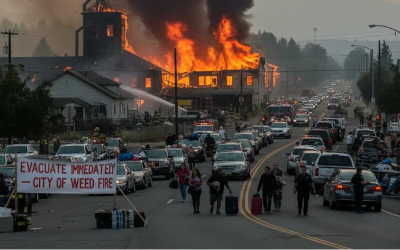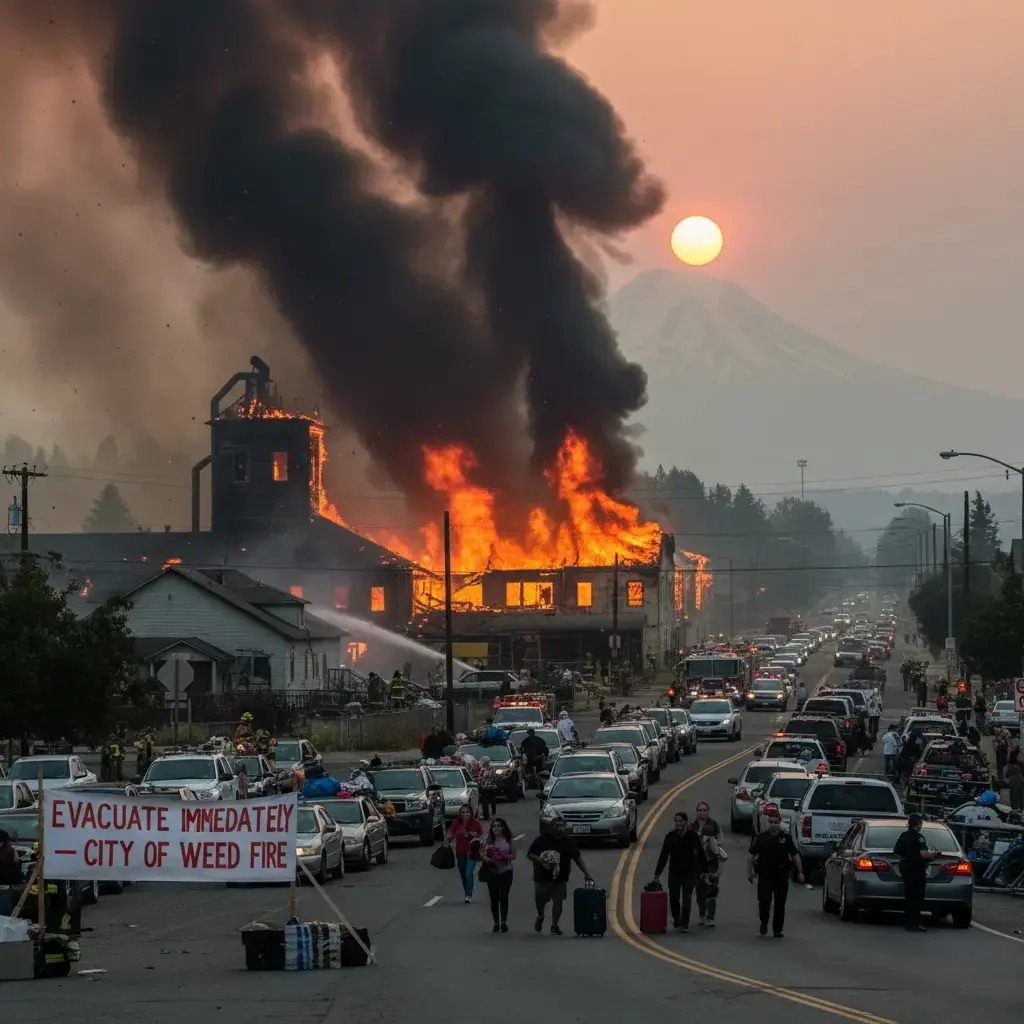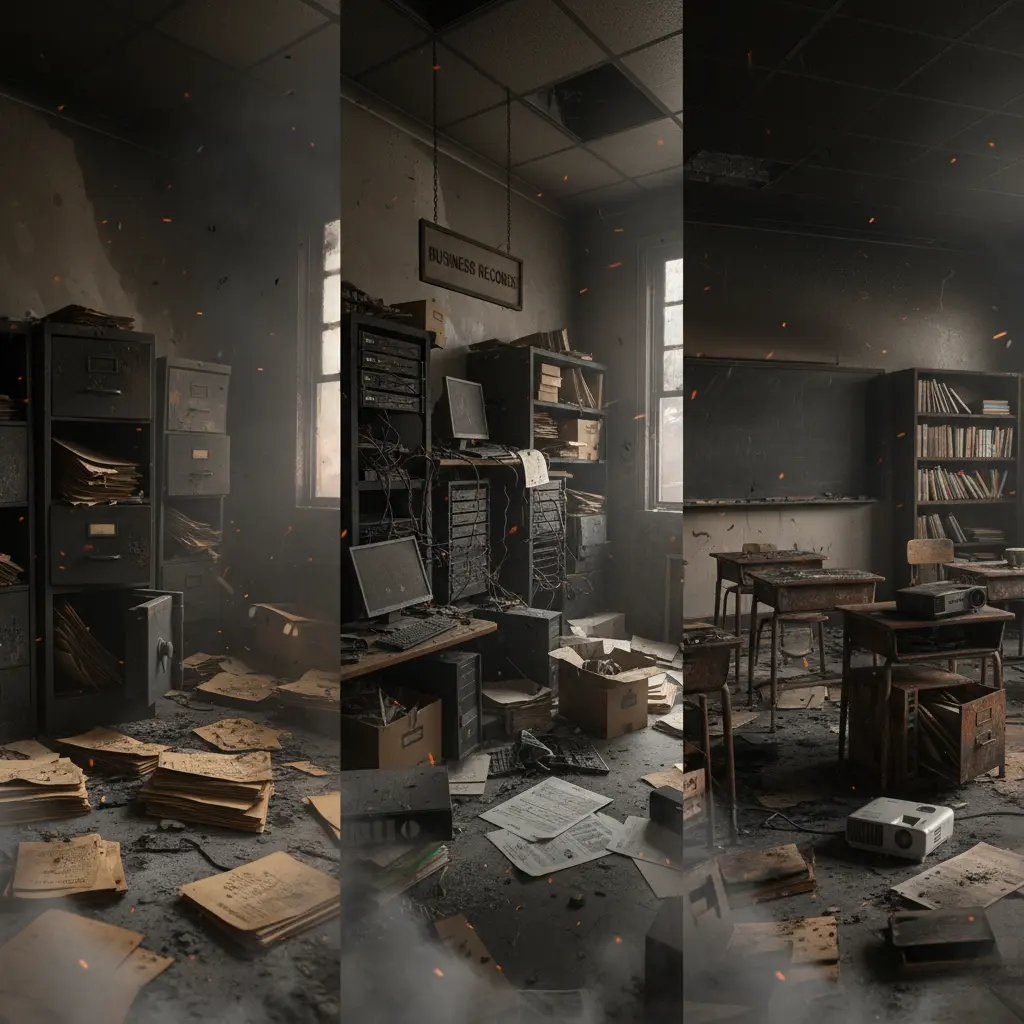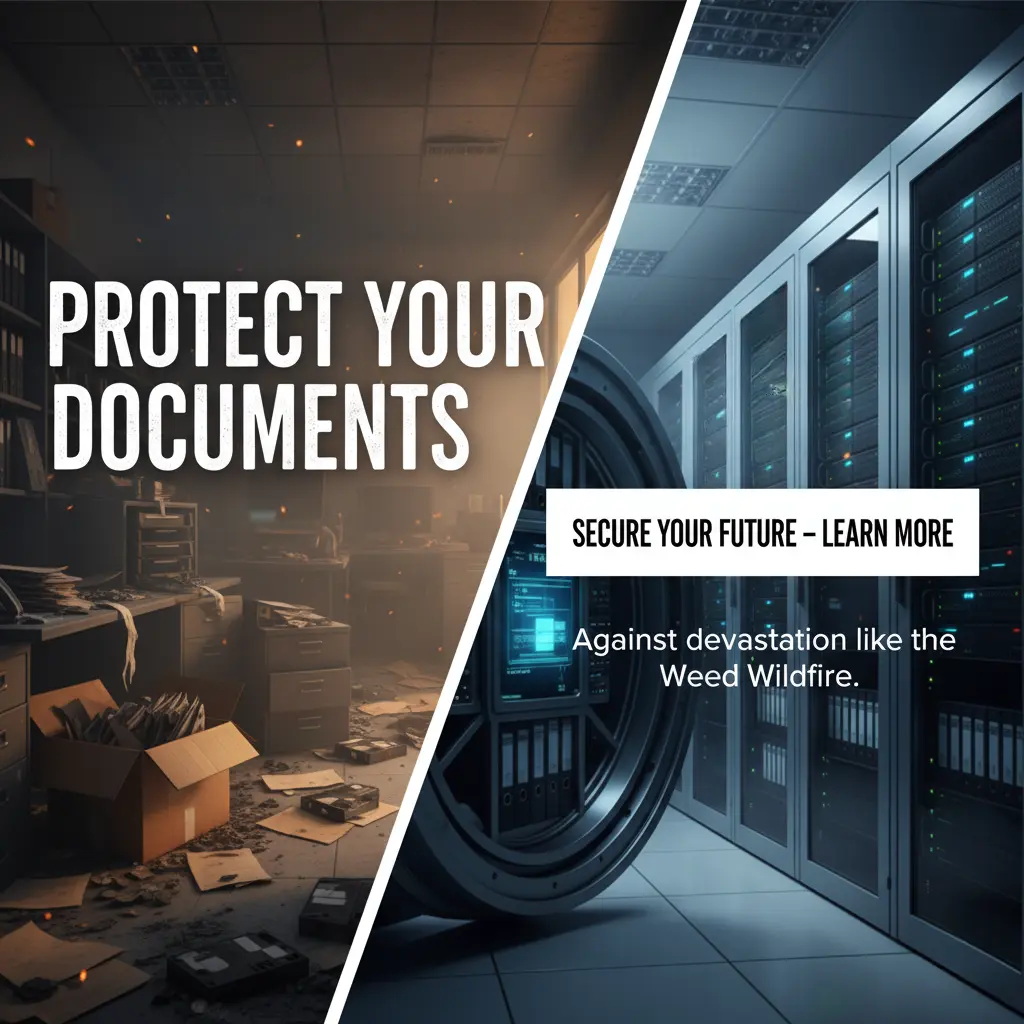When news broke that a structure fire had sparked near Main Street in Weed, California, it wasn’t just local homeowners who braced for impact — it was schools, clinics, business owners, and city departments too.
For a few tense hours on September 28, 2025, evacuation orders swept across Weed, displacing over 3,000 residents. Although the fire was eventually contained, it served as a harsh reminder: what happens to the decades of records, both personal and business, stored in filing cabinets, storage closets, and dusty archives when flames come knocking?
This isn’t a one-off story. In 2022, Weed was devastated by the Mill Fire, which destroyed thousands of acres and resulted in extensive operational and archival losses for businesses and public offices.
Why Wildfires Aren’t the Only Threat to Your Physical Records?
Fires like the one in Weed aren’t isolated. California faces a growing range of natural disasters that threaten not just structures, but the integrity of records stored in paper form.
As of 2025, several major wildfires are active. The Madre Fire in San Luis Obispo County has burned over 80,786 acres and is among the largest in the state this year.
Another recent blaze, the TCU September Lightning Complex, consumed over 13,869 acres in Tuolumne and Calaveras counties.
But it’s not just wildfires. Here are other disasters that have struck specific places and years, each carrying risks to records:
1. Wildfires
- Palisades & Eaton Fires (2025, Los Angeles area) burned 23,707 and 14,021 acres, respectively, destroying thousands of structures. CBS News
- Madre Fire (2025, San Luis Obispo County) is a current example of how quickly wildfires can expand.
2. Earthquakes
- The 1906 San Francisco earthquake (magnitude ~7.9) devastated large parts of the San Francisco Bay Area and triggered destructive fires.
- The 1933 Long Beach earthquake (magnitude ~6.4) caused widespread damage in Southern California.
- More recently, in 2024, a magnitude‑7.0 quake struck off Northern California near Ferndale, prompting tsunami warnings and shaking felt as far as San Francisco.
3. Coastal Flooding & Storms
- In February 2025, record rains in Los Angeles triggered mudslides and coastal flooding in the Pacific Palisades area.
4. Droughts
- California has endured multiple severe droughts; one recent drought from 2011 to 2017 stressed the water supply, vegetation, and contributed to fire and landslide risk.
5. Landslides
- After the 2003 Thomas Fire, heavy rains triggered deadly debris flows in Montecito, California, destroying homes and archives. ( Source – USGS )
- In La Conchita, Ventura County, a landslide in 1995 swallowed part of the coast, destroying homes and displacing families. ( Source – Emergency Management Department )
6. Severe Storms
- Storm systems over California have repeatedly caused flooding, infrastructure damage, and power outages. For example, December 2022 to March 2023 storms triggered hundreds of landslides and caused damage across the state.
And yet, despite the frequency of these fires, many agencies, schools, and businesses still rely on fragile, paper-based record systems. That’s where brands like eRecordsUSA come in — helping organizations take a proactive approach to Weed California fire records protection through digitization, indexing, and cloud backup solutions that stand up to disaster.
Because in the end, a fast-moving blaze doesn’t just threaten buildings – it endangers your institutional memory, operational continuity, and regulatory compliance.
How Wildfires Destroy Business, Agency, and School Records Without Digitization?
When wildfires or structure fires sweep through towns like Weed, they don’t just destroy buildings — they destroy the operational backbone of entire organizations. For businesses, government agencies, educational institutions, and healthcare providers, this means the loss of critical records that have been accumulated over years or even decades.
Fires can wipe out:
- HR records (contracts, benefits, onboarding files)
- Client case files (legal, financial, or patient-related)
- Compliance documents (permits, audits, certifications)
- Historical archives (board meeting minutes, engineering blueprints, research logs)
- Procurement & vendor files (bids, contracts, invoices)
And once gone, many of these paper-based records can’t be reconstructed.
What’s often overlooked is that paper records remain the legal source of truth for many public agencies and regulated industries. Without digitized backups, a single blaze can lead to:
- Regulatory violations
- Loss of licenses or accreditations
- Interrupted operations or halted services
- Lawsuits due to missing documentation
- Community trust erosion, especially in public sector roles
For example, when Southern California schools were hit by the Palisades and Eaton wildfires, districts faced significant challenges in recovering student files and administrative records. Learn how they responded:
How Schools Are Preserving Records After the Palisades & Eaton Fires?
Likewise, businesses caught in wildfires often find themselves unable to prove ownership, settle insurance claims, or maintain compliance with regulations. Here’s how to protect your most critical business and family documents:
How to Protect Your Business & Family Records from Wildfires & Disasters?
The Weed, California, fire records protection conversation isn’t just about safety; it’s about sustainability and continuity.
Which Records Should Be Digitized First to Protect Your Organization in a Disaster?
Not every document holds the same weight when a disaster strikes. That’s why one of the first steps toward fire-proofing your organization’s information infrastructure is to know what needs digitizing first.
While digitizing all records is ideal, organizations should prioritize documents that are:
- Legally required for compliance
- Operationally critical for continuity
- Difficult or impossible to replace
- Regularly accessed by multiple departments
- Linked to public trust or reputational impact
Here’s a breakdown of high-priority record categories:
1. Legal & Regulatory Records
These include contracts, licenses, permits, safety audits, and documentation required by federal/state agencies. Loss of these records can lead to fines, shutdowns, or legal consequences.
2. Internal Operations
Employee files, payroll records, benefit plans, vendor agreements, and procurement documents keep day-to-day functions running. If you lose them, your business could stall for weeks.
3. Client & Stakeholder Documentation
This category covers case files, treatment plans, loan documents, transcripts, or any records that link you directly to the people you serve. Losing these can cause immediate reputational damage.
4. Archival & Historic Files
From meeting minutes to architectural drawings and original research data—these records tell your organization’s story and validate institutional memory.
Remember: if a record’s loss would cost you money, time, or credibility, it belongs in your first wave of digitization.
Why Families Need to Digitize Personal Records Before Disaster Strikes?
While businesses and institutions carry operational risk, individuals face personal devastation:
- Loss of IDs, birth certificates, and insurance policies
- Difficulty filing disaster claims or reapplying for aid
- Loss of generational records: marriage licenses, photographs, legal settlements
Families, like businesses, must act proactively. Here’s how:
Identifying which records matter most is only the beginning. Once you’ve prioritized your documents, the next step is turning that awareness into action.
How to Build a Fire-Resistant Records Strategy with Digitization at Its Core?
Let’s explore how to build a fire-resistant records strategy that protects your information and ensures long-term continuity.
1. Start with a Records Audit
Before you can protect your records, you need to know what you have. Begin by creating a comprehensive inventory of all paper records across departments, sorted by:
- Legal importance
- Regulatory requirement
- Operational use
- Historical value
- Risk of loss or damage
Use this audit to identify high-risk storage areas, such as file rooms with no fire suppression or cabinets in older buildings.
2. Digitize Using Enterprise-Grade Standards
Don’t rely on office scanners or low-resolution PDFs. Partner with a professional provider like eRecordsUSA that offers:
- High-resolution scanning with OCR
- Indexing and metadata tagging for easy retrieval
- Support for large-format documents, microfilm, or fragile archives
- Chain-of-custody and privacy compliance for sensitive files
This level of digitization is essential for meeting standards in industries like healthcare (HIPAA), finance (PCI) , and education (FERPA).
3. Organize for Continuity
Once digitized, organize your records in a digital filing system that reflects your workflow. Use folders and tags that reflect department needs, access levels, and legal categories. Ensure there’s a clear naming convention and retrieval protocol.
4. Secure and Redundant Backups
A fire-resistant plan isn’t complete without multiple layers of protection:
- Encrypted cloud storage with version control
- Offline backups on external drives in fireproof safes
- Backups stored offsite or in separate geographic regions
- Quarterly test runs of your recovery process
5. Train and Assign Responsibility
Even the best systems fail if no one owns them. Assign responsibility for:
- Ongoing record digitization
- Backup maintenance
- Disaster response drills
- User training and access protocols
If your organization doesn’t have the tools, time, or expertise to digitize and protect high-risk records, you’re not alone. That’s precisely where eRecordsUSA fits in, bridging the gap between record vulnerability and long-term information resilience.
We specialize in helping agencies, enterprises, and institutions implement fire-resistant records strategies by digitizing all the records that go beyond surface-level scanning. Whether you’re managing school archives, legal files, or regulatory audits, our process is designed for security, compliance, and usability.
Here’s how we support fire records protection:
- Enterprise-Grade Digitization – High-resolution scanning with OCR ensures every document is searchable and legible—no matter how complex or fragile.
- Indexed and Structured Archives – We help you organize digital files into folders with metadata, logical taxonomy, and naming conventions built for scale.
- Confidential and Compliant Handling – Our workflows are designed around privacy-sensitive records and regulatory frameworks, including HIPAA, FADGI, and FERPA.
- Redundant Backup Recommendations – We work with you to guide you with cloud backups, offline storage, and access protocols for proper disaster recovery.
- Custom Solutions for Every Industry – From school districts to law firms to government agencies—we tailor digitization to your specific documentation structure and retention needs.
In short, eRecordsUSA doesn’t just scan documents—we future-proof your records so your organization stays resilient, audit-ready, and uninterrupted in the face of wildfires or any emergency.
Don’t wait until you or your entire city is asked to evacuate. Don’t wait for the next wildfire, earthquake, or storm to remind you how vulnerable your records are. Each year brings more disasters and fewer second chances.
Still have questions? Call us at 510.900.8800 or write to us at [email protected] to speak directly with a records resilience expert.
Read More –
- How Do KQED and California Revealed Help You Preserve Family Archives?
- How We Digitized the Campbell Museum& Newspaper Archive?
- How eRecordsUSA Digitized Beethoven Manuscripts for SJSU’s Ira F. Brilliant Center?
- How eRecordsUSA Digitized California State Library’s Archives for Public Access?
- How eRecordsUSA Digitized the Tompkins Conservation Archive?
- Golden Gate Bridge Archives Digitized by eRecordsUSA



